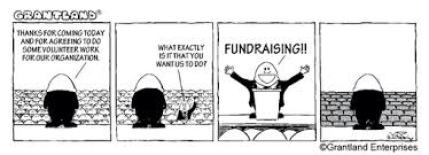
Today I’m celebrating ten years of working in the nonprofit sector doing fundraising for nonprofit organizations! When I think back on all of the experience I’ve gotten over the years, I am overwhelmed and humbled by all I’ve learned, as well as the people who have helped me learn it.
I thought I’d celebrate today by sharing the top ten lessons I’ve learned over these past ten years. Hopefully some of these tidbits can reinforce what you’ve been thinking or allow you to consider a new idea. Because that’s the thing about fundraising – we are never done learning about it.
1. While fundraising might be our world, to most people, it’s a small piece of their lives. We might toil over a fundraising letter, spend hours hundreds of hours working on a three hour fundraising gala, or write a lengthy grant proposal. While the work we are doing is important, usually, the details matter less and the intention matters more.
2. We are not fundraising for the nonprofit organization, we are fundraising for the cause. It’s easy to get caught up in all of the nuances that your organization offers, and the activities it is doing. But in the donors’ eyes, they don’t care about what you are doing, they care about why you are doing it. They care that because you exist, the world is a little different. And that’s what we’re working for.
3. Donor centric communications and activities are key. Being wrapped up in the organization you work for can easily lead to communications and activities that are full of organization-specific jargon. As often as you can, take a step back from your communications and read it with fresh eyes. Remember, donors just want to change the world. Your organization is just the way to do so.
4. It’s all about the relationships. Maintaining relationships with donors is just like maintaining relationships with your friends or loved ones – it’s important to keep them updated through the good times and the bad. No friend is going to stick by your side if you ask for a favor every time you call them. Cultivation and stewardship should make up 90% of your communication with a donor – solicitation should be 10% at most.
5. Fundraising is not a dirty word. Society has made us scared to talk about money. Many people think there are power dynamics at play when it comes to money, so they think of fundraising as begging. That couldn’t be further from the truth. Every organization, nonprofit or otherwise, needs money to function. Donors know that, and they want to be part of the change.
6. Fundraising is a two way street. We need donors just as much as donors need us. Fundraising is an equal exchange, where donors get just as much out of the relationship as nonprofit organizations do. There are a plethora of benefits that donors enjoy in making a donation, everything from changing the world to public recognition to tax benefits.
7. There is always more work to be done. There are always more donors to thank, prospects to find, research to do, solicitations to be made… the work is never done.
8. Fundraisers need to take care of themselves. Since the work is never done, it can be easy to burn out. Expectations just keep growing higher and needs of program staff just keep increasing – which is great – but, we need to remember that we are not all miracle workers. We must do our best and accept that it is enough.
9. Fundraisers need to take care of each other. We are a community. It is time to band together and support each other in the work we are doing – whether through professional associations or informal meet ups. We are our best allies!
10. The learning is never done. As I mentioned in the beginning, there is always something new to learn. The field is always changing and it’s imperative to keep up. That’s part of what I love most about fundraising – it’s always changing.
I am tremendously grateful for all of the experiences I have had and the people who have been part of my journey. You know who you are! Here’s to the next ten years – I have a feeling I’ll be impacting even more nonprofit organizations through my work!
-N.C.









